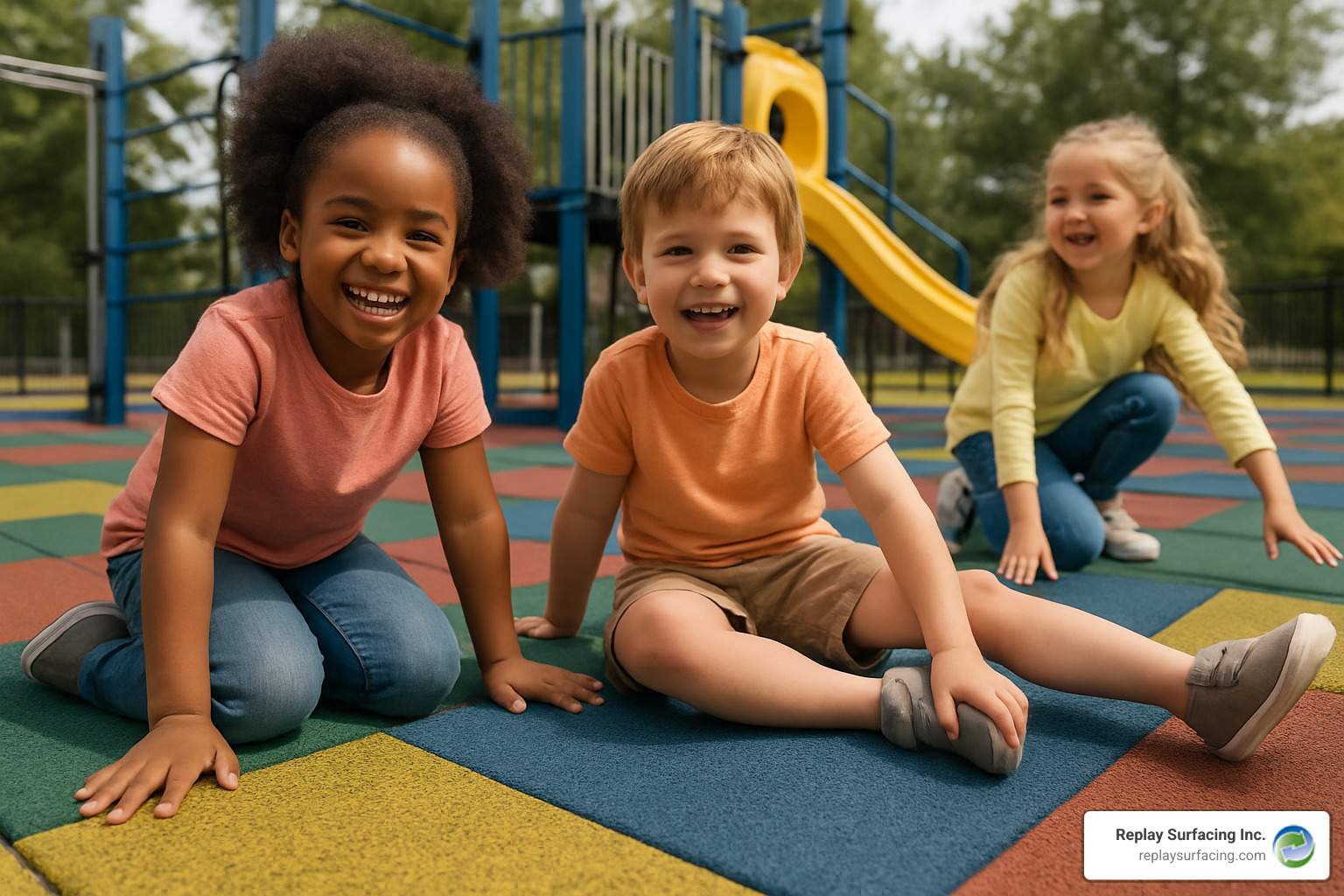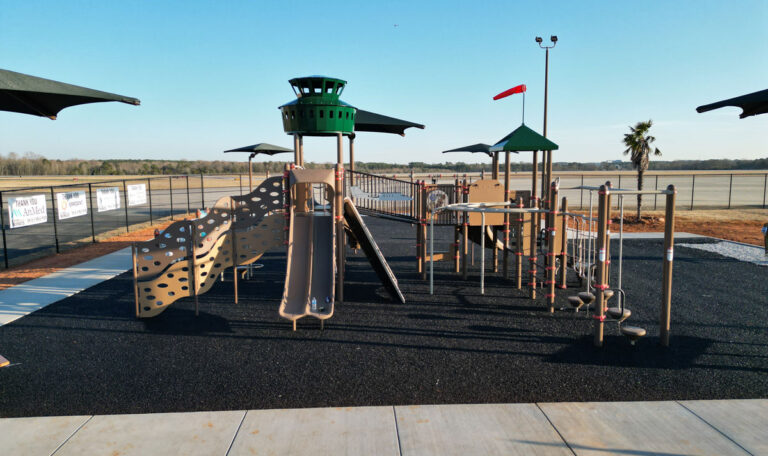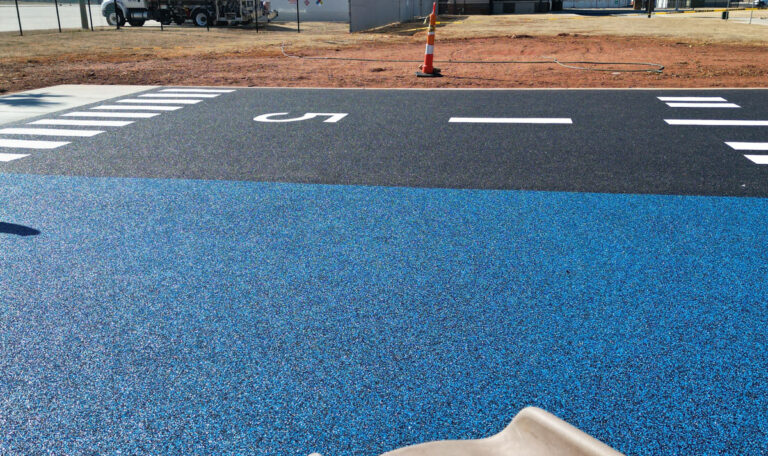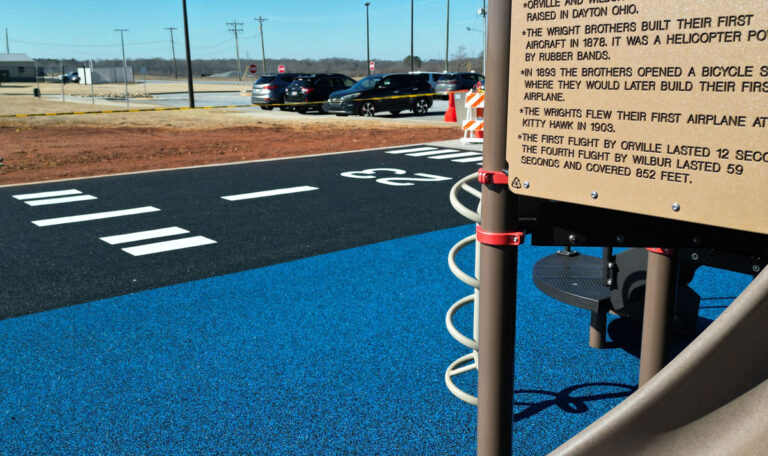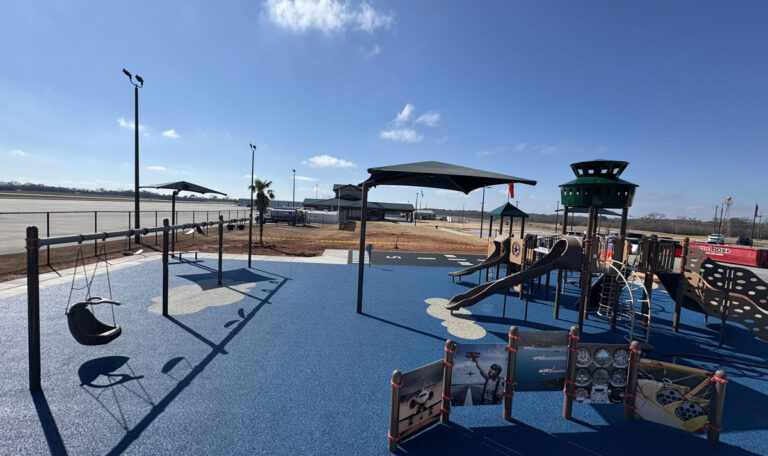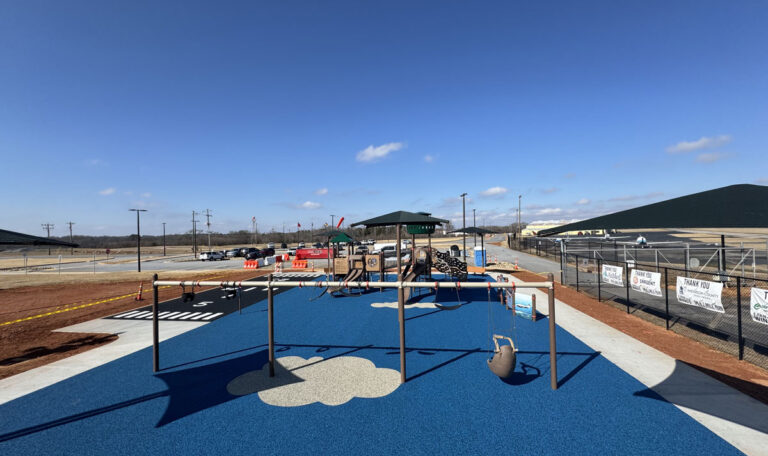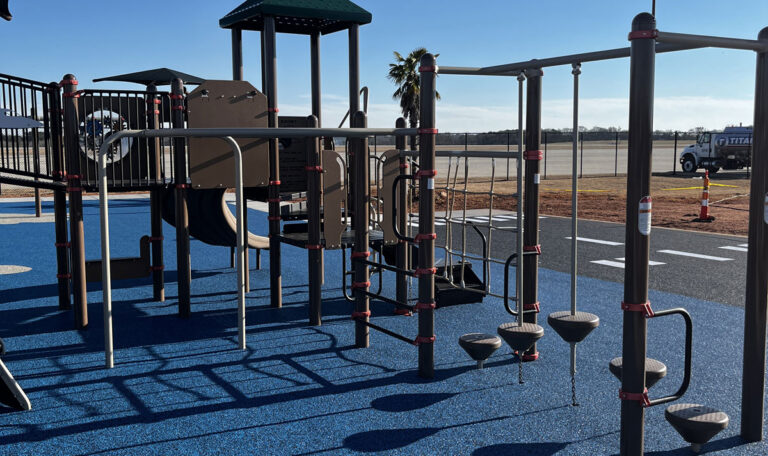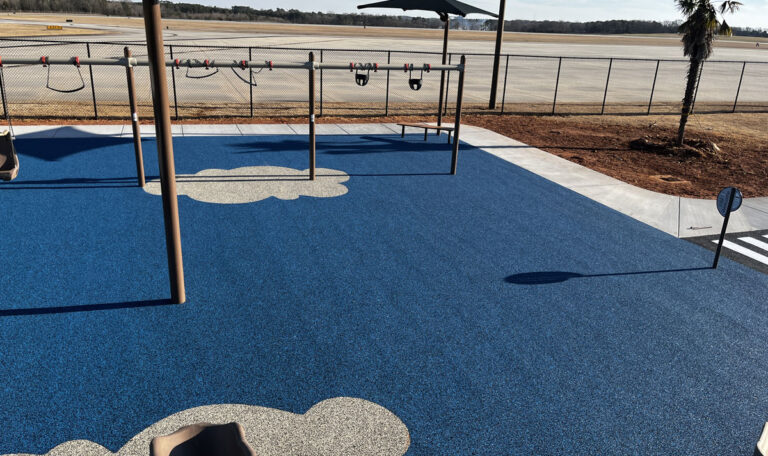Why Non-Toxic Playground Surfaces Are Essential for Children’s Health
Non toxic playground tiles offer the safest, most sustainable way to protect children during play while eliminating harmful chemicals from their environment. These specialized rubber surfaces provide superior fall protection without exposing kids to toxins like phthalates, heavy metals, or volatile organic compounds (VOCs) found in many traditional playground materials.
Key benefits of non-toxic playground tiles:
• Zero harmful chemicals – No phthalates, lead, or red-list substances
• Superior safety – Meet ASTM F1292 standards for fall protection up to 12 feet
• Hypoallergenic – Safe for children with sensitivities and allergies
• ADA compliant – Provide accessible surfaces for all children
• Long-lasting – 10-20 year lifespan with minimal maintenance
• Eco-friendly – Made from recycled materials, 100% recyclable
With over 200,000 playground injuries occurring annually and falls accounting for 70% of all playground accidents, choosing the right surface material isn’t just about comfort—it’s about preventing serious injuries while protecting children’s long-term health.
I’m Landon Olson, a mechanical engineer with an MBA who has spent years working in safety surfacing and sustainability. Through my experience at Replay Surfacing, I’ve helped countless facilities transition to non toxic playground tiles that meet the highest safety and environmental standards.

Basic non toxic playground tiles glossary:
– installing playground tiles
– softfall rubber bunnings
– rubber wetpour diy
Why Non-Toxic Playground Tiles Matter
Picture this: your child spends an afternoon at the playground, rolling down slides, climbing monkey bars, and inevitably ending up with scraped knees and dirt-covered hands. What you might not see is the invisible exposure happening through their skin and lungs from the playground surface itself.
Many traditional playground materials contain a hidden cocktail of harmful chemicals. VOCs (volatile organic compounds) quietly off-gas into the air your children breathe. Heavy metals like lead and cadmium can leach from inferior surfaces. Red-list chemicals and phthalates—substances known to disrupt hormones and development—lurk in many conventional playground installations.
Here’s what makes this particularly concerning: children’s bodies absorb these toxins differently than adults. Their smaller size means proportionally higher exposure, and their developing nervous and immune systems are far more vulnerable to chemical damage that could affect them for life.
The safety stakes go beyond chemical exposure. Fall injuries account for roughly 70% of all playground accidents, making proper impact protection absolutely critical. The Scientific research on safer surfacing from the Consumer Product Safety Commission shows exactly how the right surface can prevent serious injuries. This is where Shock Absorbing Playground Surfaces become essential—not just for comfort, but for preventing concussions and broken bones.
Non toxic playground tiles address both the seen and unseen dangers. They eliminate harmful chemical exposure while providing superior fall protection. Plus, they meet ADA access requirements, ensuring every child can play safely regardless of their mobility needs.
Health Benefits of Non Toxic Playground Tiles
The most immediate benefit of non toxic playground tiles is concussion reduction. When properly installed at 2.5 inches thick, quality tiles safely absorb impacts from falls up to 6 feet high. This isn’t just marketing speak—it’s backed by ASTM F1292 testing that measures exactly how much force reaches a child’s head during a fall.
The hypoallergenic properties make these tiles a game-changer for children with sensitivities. Unlike surfaces containing latex or other common allergens, quality non-toxic tiles are formulated to be gentle on even the most sensitive skin. We’ve seen playgrounds become truly inclusive when facilities make this switch.
Perhaps most importantly, the complete absence of phthalates eliminates exposure to chemicals linked to hormonal disruption and developmental issues. When tiles are manufactured from virgin rubber or carefully screened recycled materials, parents can breathe easier knowing their children aren’t absorbing harmful substances during play.
Environmental Benefits of Non Toxic Playground Tiles
Non toxic playground tiles tell a remarkable environmental story—changing waste into something wonderful. Quality tiles incorporate recycled content from materials that would otherwise clog landfills. This circular economy approach means yesterday’s discarded tires become tomorrow’s safe play surfaces.
Think about it: millions of tires reach the end of their road life every year. Without proper recycling, they pile up in landfills or illegal dumps where they leach chemicals and become mosquito breeding grounds. Landfill diversion through tire recycling solves a genuine environmental problem while creating something beneficial.
The durability factor amplifies these environmental benefits dramatically. With proper installation and basic maintenance, these surfaces last 10-20 years—far longer than organic alternatives like wood mulch that need constant replacement. This longevity means fewer resources consumed and less waste generated over the playground’s lifetime.

Inside a Non-Toxic Playground Tile: Materials, Testing & Certifications
When you’re choosing playground surfaces for children, it’s not enough to trust marketing promises about safety. Understanding what actually goes into non toxic playground tiles helps you make informed decisions that protect kids while creating play spaces that last for decades.
The best non-toxic tiles start with carefully selected materials. Virgin rubber remains the gold standard because it hasn’t been exposed to contaminants or degradation from previous use. EPDM rubber (ethylene propylene diene monomer) brings exceptional weather resistance to the mix—it won’t crack in winter freezes or fade under intense summer sun. When manufacturers add color, they use lead-free pigments that stay vibrant without leaching harmful metals.
SBR rubber (styrene-butadiene rubber) provides the cushioning that makes these tiles so effective at preventing injuries. This material excels at shock absorption, turning what could be a dangerous fall into a manageable bump.
The certification process separates quality products from cheap imitations. ASTM F1292 testing measures how well surfaces cushion falls—it’s the standard that determines whether a tile can safely handle a fall from 6 feet or 12 feet. ASTM F1951 ensures the surface meets ADA accessibility requirements, so children using wheelchairs or mobility devices can steer playground areas safely.
CPSC guidelines provide the overall safety framework that playground surfaces must meet. IPEMA certification adds an extra layer of confidence through independent third-party verification. For chemical safety, EN 71-3 testing simulates what happens if children put playground materials in their mouths—because we all know kids explore the world that way.
The ASTM F1292 surfacing standard establishes the testing methods that determine critical fall height ratings. Our Recycled Rubber Playground Flooring consistently meets and exceeds these requirements, giving you confidence in both safety and performance.
Quality tiles also pass slip resistance testing for both wet and dry conditions. After all, playgrounds don’t shut down when it rains, and kids need safe footing whether they’re running in sunshine or navigating puddles.
How Non-Toxic Status Is Verified
Real verification happens in third-party laboratories that have no financial interest in the test results. These accredited labs put tiles through comprehensive VOC testing to measure any chemicals that might off-gas from the surface. Even though most playgrounds are outdoors, children spend considerable time with their faces close to playground surfaces during play.
The most valuable document you can request is a certificate of analysis that shows actual test results rather than just claims. This certificate should cover testing for heavy metals like lead and cadmium, phthalates that can disrupt hormones, and red-list chemicals identified as particularly harmful to human health.
Smart manufacturers test their finished products, not just raw materials. Manufacturing processes can introduce contamination, so testing the final tile gives you the real safety picture. Look for testing that goes beyond minimum requirements—the best manufacturers screen for substances that aren’t even regulated yet but are known to cause health concerns.
Are Recycled Rubber Tiles Safe?
The safety of recycled rubber tiles depends entirely on the source materials and processing methods. High-quality recycled tiles start with recycled tire sourcing from known suppliers, not random tire piles of unknown origin.
The manufacturing process includes thorough metal screening to remove steel belting and other contaminants that could create safety hazards. Proper processing breaks down and removes many potentially harmful compounds that existed in the original tires, sometimes making recycled rubber safer than the original material.
Odor control serves as a reliable indicator of processing quality. While any rubber product might have a slight smell when new, strong or persistent odors usually signal incomplete processing or contaminated materials. Quality non toxic playground tiles made from recycled rubber should have minimal odor that fades quickly after installation.
The recycling process itself adds environmental benefits without compromising safety. When done properly, it transforms waste tires—which can leach chemicals in landfills—into safe, durable playground surfaces that protect children for decades.

Non-Toxic Tiles vs. Other Playground Surfaces: A Side-By-Side Comparison
Choosing the right playground surface feels overwhelming when you’re faced with so many options. Let me walk you through how non toxic playground tiles stack up against other popular surfaces, so you can make the best decision for your playground.
The playground surfacing world splits into two main camps: unitary surfaces (like tiles and poured-in-place rubber) and loose-fill materials (like engineered wood fiber and rubber mulch). This distinction matters more than you might think.
Unitary surfaces stay put. They won’t blow away during windstorms, wash out in heavy rain, or get kicked around by enthusiastic kids. Loose-fill materials, while often cheaper upfront, require constant attention to maintain proper depth and coverage.
Poured-in-place rubber offers seamless installation and works beautifully for complex playground layouts with lots of curves and equipment legs. However, it requires specialized installation equipment and professional crews, making it one of the priciest options at $22-32 per square foot.
Engineered wood fiber wins the budget competition at just $3-5 per square foot initially. But here’s the catch—it needs frequent raking, regular replenishment, and complete replacement every 3-5 years. Those ongoing costs add up faster than you’d expect.
Rubber mulch provides decent impact protection at $5-6 per square foot, but it gradually compacts and disperses. You’ll find yourself adding new material regularly, and wheelchairs struggle with the loose surface.
Synthetic turf looks fantastic and feels great underfoot, but it can become scorching hot in direct sunlight. Many synthetic turf systems also require infill materials that may present their own safety concerns.
| Surface Type | Safety Rating | Maintenance | Initial Cost | Accessibility | Lifespan |
|---|---|---|---|---|---|
| Non-Toxic Rubber Tiles | Excellent | Low | Moderate-High | Excellent | 10-20 years |
| Poured-in-Place Rubber | Excellent | Low | High | Excellent | 10-15 years |
| Engineered Wood Fiber | Good | High | Low | Fair | 3-5 years |
| Rubber Mulch | Good | Moderate | Low-Moderate | Good | 5-10 years |
| Synthetic Turf | Good | Moderate | High | Good | 8-12 years |
When you calculate lifecycle cost over 15-20 years, the picture changes dramatically. Those “expensive” tiles often become the most economical choice when you factor in minimal maintenance requirements and their impressive longevity.
Accessibility presents another crucial consideration. Non toxic playground tiles create smooth, stable surfaces that wheelchairs and walkers steer easily. This ADA compliance isn’t just about following regulations—it’s about creating truly inclusive play spaces where every child can participate.
Pros & Cons Snapshot
Let’s be honest about what non toxic playground tiles do well and where they present challenges.
The impact attenuation performance of quality tiles is outstanding and predictable. Unlike loose materials that can thin out or compact unevenly, tiles maintain consistent protection across the entire surface. You won’t find surprise thin spots that could lead to injuries.
The upkeep burden practically disappears with tiles. No more weekend raking sessions or emergency mulch deliveries after storms. A quick sweep and occasional hose rinse keeps them looking great for years.
However, the upfront cost can cause sticker shock. Quality tiles typically cost more initially than loose-fill alternatives. But when you spread that cost over 15-20 years and eliminate ongoing maintenance expenses, the math often favors tiles.
Installation flexibility presents another consideration. While tiles accommodate most playground layouts beautifully, they can’t match the seamless custom curves possible with poured-in-place systems. Most playgrounds work perfectly with tiles, but complex designs might benefit from other approaches.
The durability advantage becomes clear over time. Weather extremes, heavy use, and normal wear affect tiles minimally. Individual damaged tiles can be replaced easily without disturbing the entire surface—try doing that with poured rubber!
Perhaps most importantly, quality non toxic playground tiles maintain their safety performance consistently. The impact protection you get on installation day remains virtually unchanged years later, giving you confidence that children stay protected throughout the surface’s long lifespan.

Performance, Weather & Installation Essentials
When you’re investing in non toxic playground tiles, understanding how they perform in real-world conditions makes all the difference between a surface that lasts decades and one that disappoints. These tiles are engineered to handle everything from scorching summer heat to freezing winter conditions while maintaining their safety performance year after year.
Impact attenuation is where the science really shines. A 2.5-inch thick tile can safely protect children from falls up to 6 feet high, while stepping up to 3.25-inch tiles extends that protection to 8-foot falls. It’s not a simple math equation though—each additional quarter-inch provides incrementally more protection, but you’ll see the cost increase accordingly. The key is matching your tile thickness to your playground’s actual fall height requirements rather than over-engineering (and overspending) on protection you don’t need.
Drainage channels built into quality tiles prevent the puddles that can turn playgrounds into slip hazards. Water flows right through to the substrate below, which means kids can get back to playing faster after rain storms. This drainage becomes absolutely critical in freeze-thaw climates where standing water can create dangerous ice patches or even damage the tiles themselves.
Here’s something that surprises many facility managers: heat reflectance varies dramatically between tile colors. Light-colored tiles stay much cooler than dark ones, which matters when barefoot children are playing on hot summer days. Even so, rubber tiles typically stay cooler than concrete or asphalt surfaces that can become scalding hot.
Slip resistance remains consistent whether the surface is wet or dry, thanks to the engineered texture that provides traction without being rough on skin during falls. It’s one of those engineering balances that sounds simple but requires real expertise to get right.
The base preparation you choose significantly affects how long your tiles will last and how well they’ll perform. While non toxic playground tiles can go over existing concrete, dirt, or compacted gravel, taking time for proper preparation prevents settling issues that could create trip hazards down the road.
With proper installation and basic maintenance, you can expect a lifespan of 10-20 years from quality tiles. Regular inspection helps catch small issues before they become expensive problems. Our DIY Playground Rubber Flooring guide walks through everything facilities need to know about self-installation.
For areas that see particularly heavy use, our Improve Safety with Rubber Playground Mats resource explains how strategic placement of additional protection can boost safety in high-traffic zones.
Installation Steps for Non Toxic Playground Tiles
Installing non toxic playground tiles correctly isn’t rocket science, but getting the details right makes the difference between a surface that performs beautifully for decades and one that develops problems within a few years.
Site grading comes first, and it’s more important than many people realize. You want a gentle slope of 1-2% to move water away from play structures without creating an uneven playing surface. Remove all the debris, vegetation, and loose materials that could cause settling issues later.
For base preparation over dirt or grass, you’ll need to excavate 2-4 inches and install a compacted gravel base. This provides the stable foundation that prevents tiles from shifting over time. If you’re installing over existing concrete, make sure it’s clean, level, and free of cracks that could show through the tiles.
Geotextile fabric goes down next when you’re installing over grass or dirt. This landscape fabric stops weeds from growing up through the surface while still allowing water to drain properly. It’s optional over concrete but can help with moisture management.
The actual tile installation is surprisingly straightforward with quality products. Most tiles use interlocking dowel systems that align automatically as you install them. Start from one corner and work systematically across the area. The dowels ensure proper spacing and create a unified surface that won’t develop gaps over time.
Don’t forget the edge ramps around the perimeter. These beveled transitions eliminate trip hazards and are essential for ADA compliance. They’re one of those details that seem minor until someone trips over an unfinished edge.
Walk the entire surface for your final inspection. Check that all connections are secure, the surface is level, and drainage flows properly. Make any adjustments now rather than after kids start using the playground.
Maintenance Made Simple
One of the best things about non toxic playground tiles is how little maintenance they actually need. Unlike loose-fill surfaces that require constant raking and replenishment, tiles just need basic care to look and perform their best.
Weekly sweeping removes debris and prevents organic material from building up in the joints between tiles. A leaf blower makes quick work of larger areas. Monthly hose rinsing keeps the surface looking fresh and removes accumulated dirt.
Quarterly inspections catch problems while they’re still small and inexpensive to fix. Look for loose tiles, damaged edges, or drainage issues that need attention. In areas with lots of trees, you might need to remove debris more frequently, but that’s about as complicated as it gets.
Annual deep cleaning with mild detergent and a low-pressure washer can restore the surface to like-new appearance and remove any staining that’s developed. Skip the harsh chemicals or high-pressure washing that could damage the surface texture you need for proper traction.
The 12-year color guarantee on quality tiles means your playground will maintain its vibrant appearance with minimal effort on your part. This durability translates directly into lower total cost of ownership and less work for your maintenance team.
Choosing & Verifying the Right Non-Toxic Tiles
Finding the perfect non toxic playground tiles for your facility doesn’t have to feel overwhelming. Think of it like choosing a car—you want something safe, reliable, and within your budget that will serve you well for years to come.
Start by understanding your safety requirements. Walk around your playground and identify the highest points where children might fall. This critical fall height determines the tile thickness you’ll need. A swing set might require different protection than a climbing structure, so don’t assume one thickness fits all areas.
Budget planning goes beyond the sticker price. Yes, quality tiles cost more upfront than wood chips, but consider this: over 15 years, you might replace wood chips three times while your tiles are still going strong. Factor in installation costs, but the minimal maintenance requirements mean you’ll save money and time year after year.
When it comes to verification, don’t just take marketing claims at face value. Ask for detailed lab reports that document non-toxic status. Quality manufacturers are proud of their testing and will readily share comprehensive results covering heavy metals, VOCs, and other potentially harmful substances. If a supplier hesitates to provide this documentation, that’s a red flag.
Warranty terms tell you a lot about a manufacturer’s confidence in their product. Look for warranties covering both performance (will it still protect from falls?) and appearance (will the colors fade?). Read the fine print to understand what maintenance is required to keep your warranty valid.
Sample evaluation is your chance to kick the tires, so to speak. Order samples to see actual color, texture, and quality. Photos can be deceiving, and seeing the real thing helps you make confident decisions about appearance and durability.
Supplier transparency matters more than you might think. Companies that openly discuss their manufacturing processes, material sourcing, and quality control procedures typically deliver higher quality products. If a supplier is vague about these details, consider looking elsewhere.
Our Playground Safety Surfacing Company has guided facilities through this selection process countless times. We believe that when you have all the information, choosing the right surface becomes much clearer.
Frequently Asked Questions about Non Toxic Playground Tiles
Do non toxic playground tiles have an odor?
Quality non toxic playground tiles might have a mild “new rubber” smell right after installation—think new car smell rather than chemical factory. This light scent typically fades within days and poses no health concerns whatsoever.
Tiles manufactured in the US with American-sourced materials generally have less odor than imported alternatives. If you encounter tiles with a strong, persistent chemical smell, that’s often a sign of lower quality materials or incomplete curing processes. Trust your nose—quality tiles shouldn’t make you want to hold your breath.
Can tiles be installed over existing concrete?
Absolutely! Non toxic playground tiles work beautifully over existing concrete, and it’s often the most cost-effective installation option. Your concrete should be reasonably level and free of major cracks, but small imperfections won’t cause problems.
Make sure the concrete slopes away from play structures for proper drainage. The tiles will immediately transform that hard, unforgiving surface into a cushioned, comfortable play area. No special underlayment needed—just clean concrete and quality tiles.
How long will non toxic playground tiles last?
Expect your non toxic playground tiles to serve faithfully for 10-20 years, depending on your climate and how heavily the playground gets used. Quality tiles made with vulcanized rubber maintain their bounce and color throughout their lifespan.
Cold weather might make them contract slightly, but they won’t crack or lose their protective qualities. Most manufacturers back this durability with warranties of 10+ years covering both performance and color retention. With basic maintenance—really just occasional sweeping and rinsing—your tiles should easily reach their full lifespan potential.

Make a safe choice for your playground — read our simple guide to toxic vs. non-toxic rubber mulch here
Conclusion
Choosing non toxic playground tiles represents a commitment to both immediate safety and long-term health for the children who use your playground. With over 200,000 playground injuries occurring annually and 70% involving falls, the impact attenuation provided by quality tiles can literally be life-saving. But beyond basic safety, these surfaces eliminate exposure to harmful chemicals while providing years of reliable, low-maintenance performance.
The decision-making process should prioritize verified non-toxic status through comprehensive lab testing, appropriate safety certifications including ASTM F1292 compliance, and transparent manufacturing processes. While the initial investment may be higher than some alternatives, the combination of durability, minimal maintenance, and superior safety performance makes non toxic playground tiles an excellent long-term value.
Your verification checklist:
– [ ] Lab reports confirming absence of heavy metals, phthalates, and VOCs
– [ ] ASTM F1292 certification for appropriate fall heights
– [ ] ADA compliance documentation
– [ ] Warranty coverage for both performance and appearance
– [ ] Clear documentation of materials and manufacturing processes
– [ ] References from similar installations
At Replay Surfacing Inc., we transform environmental hazards into sustainable, safe playground surfaces that protect children while supporting environmental responsibility. Our experience across diverse climates and applications has shown us that the right surfacing choice creates safer, more accessible play environments that serve communities for decades.
For more information about creating safer play spaces, visit our More info about playground solutions page. Choose wisely—your decision today shapes the safety and health of countless children who will play, learn, and grow on these surfaces for years to come.
The investment in truly non-toxic playground surfaces pays dividends in reduced injuries, lower maintenance costs, and the peace of mind that comes from knowing you’ve chosen the safest option available. When children face enough challenges, their playground surface shouldn’t be one of them.

